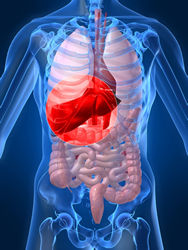HIV/HBV
Coinfected Patients with Elevated ALT and AST Are
at Greater Risk for Liver Disease Progression
By
Liz Highleyman
 Due
to overlapping risk factors, many people are coinfected
with both HIV and
HBV. Research suggests
that such individuals tend to experience more rapid
liver disease, but the natural history of disease
in this population is not fully understood.
Due
to overlapping risk factors, many people are coinfected
with both HIV and
HBV. Research suggests
that such individuals tend to experience more rapid
liver disease, but the natural history of disease
in this population is not fully understood.
P. Sellier and colleagues from France performed a
study to characterize liver-related morbidity, mortality,
and related risk factors in 107 HIV/HBV coinfected
patients. A majority (61%) were from sub-Saharan Africa,
while most of the rest (33%) were European. With regard
to hepatitis B management, 78% were treated with lamivudine
(3TC, Epivir-HBV) and 44% underwent liver biopsies.
The researchers collected clinical, biological, and
virological data every 3 months. Liver-related mortality
and a composite score were used to define advanced
liver disease.
Results
 |
19
of the 107 patients (18%) were diagnosed with
advanced liver disease during a mean follow-up
period of 4.8 years: |
| |
 |
10
with extensive fibrosis; |
 |
5
with cirrhosis; |
 |
3
with hepatocellular carcinoma resulting
from cirrhosis; |
 |
1
with fulminant hepatitis following lamivudine
discontinuation. |
|
 |
11
patients died overall, 4 of them from HBV-related
liver disease. |
 |
In
a univariate analysis, factors associated with
increased risk of advanced liver disease were
male sex, higher mean HIV and HBV viral loads,
and elevated levels of alanine and aspartate transaminase
(ALT and AST). |
 |
In
a multivariate analysis adjusting for other factors,
the strongest associations were mean AST level
and cumulative time on lamivudine. |
 |
39%
of patients with elevated mean AST developed advanced
liver disease, compared with just 7% of those
with normal mean AST (relative risk 5.5). |
"During HIV/HBV coinfection, transaminase levels
are strongly associated with advanced liver disease,"
the study authors wrote. "Normal mean AST has
a high negative predictive value, contrary to previously
reported data in HIV/HCV patients."
Elevated ALT and AST are biomarkers of liver inflammation,
not fibrosis. Other researchers have shown that hepatitis
B monoinfected, hepatitis C monoinfected, and HIV/HCV
coinfected patients may develop advanced liver damage
despite persistently normal ALT levels.
Service de Médecine Interne, Service de
Bactériologie - Virologie & Centre d'Informations
et de Soins de l'Immunodéficience Humaine,
A, Hôpital Lariboisière, Assistance Publique-Hôpitaux
de Paris, Paris, France; Immeuble SCOR, 1, avenue
du General de Gaulle, Paris la Défense Cedex,
France.
1/19/10
Reference
P Sellier, N Schnepf, I Jarrin, and others. Description
of liver disease in a cohort of HIV/HBV coinfected
patients. Journal of Clinical Virology 47(1):
13-17 (Abstract).
January 2010.